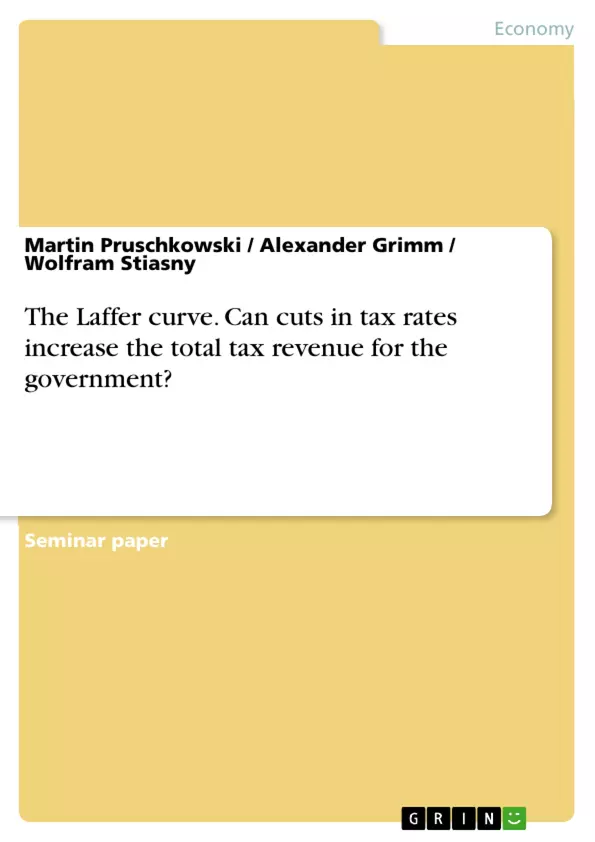Apparently mapped out on a napkin during a dinner with the journalist Jude Wanniski in 1974, the Laffer curve - called after Arthur B. Laffer who is widely seen as “The father of supply-side economics” - has become one of the most controversially discussed topics in terms of tax politics since published by the before mentioned journalist in 1978.
As taxes are the most important income source for all governments, politicians around the globe are trying to determine the highest realizable tax revenue. Therefore they are using whatever they can to justify their decisions and the Laffer curve was and is used since the 80’s to promote tax cuts as a way to increase tax revenue. The objective of this work is to analyse a tool that is consistently used to establish decisions that sound great in the ears of potential voters but that is – at least at first glance – not very convincing in its approach as there are obvious conceptual limitations. Ultimately the question Laffer curve is suited to increase the total tax revenue by cutting tax rates.
Inhaltsverzeichnis (Table of Contents)
- Preface
- Table of Contents
- List of Abbreviations
- List of Figures
- List of Tables
- List of equations
- 1. Introduction
- 1.1 Objectives
- 1.2 Structure
- 2. The Laffer-curve
- 2.1 The theory behind the graph
- 2.2 Elasticity
- 2.3 Taxes and elasticity
- 2.4 Inconsistencies within the Laffer curve
- 3. Case study: Reagan Tax Cuts in the early 1980s
- 3.1 Background on Reagan Tax program
- 3.2 Methodology
- 3.3 Results of income groups analysis
- 3.4 Conclusion of the case study
- 4. Case study: Tobacco tax program in Germany
- 4.1 Background on the tobacco tax program in Germany
- 4.2 Methodology
- 4.3 Demand and elasticity of cigarettes
- 4.4 Elasticity and tax revenues of cigarettes
- 4.5 Conclusion of the case study
- 5. Conclusion
Zielsetzung und Themenschwerpunkte (Objectives and Key Themes)
This assignment aims to analyze the Laffer curve and its implications for tax policy. The authors explore the theory behind the curve, examine its elasticity, and discuss inconsistencies within its framework. By analyzing two case studies – Reagan’s tax cuts in the early 1980s and the tobacco tax program in Germany – the assignment investigates the impact of tax policies on economic outcomes.
- The Laffer Curve and its theoretical underpinnings
- The relationship between tax rates and tax revenue
- The role of elasticity in determining tax policy effectiveness
- Real-world examples of tax cuts and their impact on economic growth
- The potential consequences of tax cuts on government revenue
Zusammenfassung der Kapitel (Chapter Summaries)
- Chapter 1: Introduction: This chapter introduces the concept of the Laffer curve and outlines the objectives and structure of the assignment.
- Chapter 2: The Laffer-curve: This chapter delves into the theory behind the Laffer curve, explaining its key concepts and discussing the role of elasticity in its framework. The authors also analyze potential inconsistencies within the Laffer curve.
- Chapter 3: Case study: Reagan Tax Cuts in the early 1980s: This chapter examines the impact of Reagan’s tax cuts on the US economy. It provides background information on the tax program, outlines the methodology used, and analyzes the results of income groups analysis. Finally, it concludes by evaluating the effectiveness of the tax program.
- Chapter 4: Case study: Tobacco tax program in Germany: This chapter investigates the tobacco tax program in Germany. It provides background information on the program, explains the methodology used, and analyzes the demand and elasticity of cigarettes. It also assesses the impact of elasticity on tax revenues from cigarettes. Finally, the chapter concludes with an evaluation of the program’s effectiveness.
Schlüsselwörter (Keywords)
The Laffer curve, tax policy, elasticity, tax revenue, tax cuts, Reagan tax cuts, tobacco tax, economic growth, government revenue, case study, methodology, demand, supply, income groups analysis.
- Arbeit zitieren
- Martin Pruschkowski (Autor:in), Alexander Grimm (Autor:in), Wolfram Stiasny (Autor:in), 2014, The Laffer curve. Can cuts in tax rates increase the total tax revenue for the government?, München, GRIN Verlag, https://www.grin.com/document/432952



